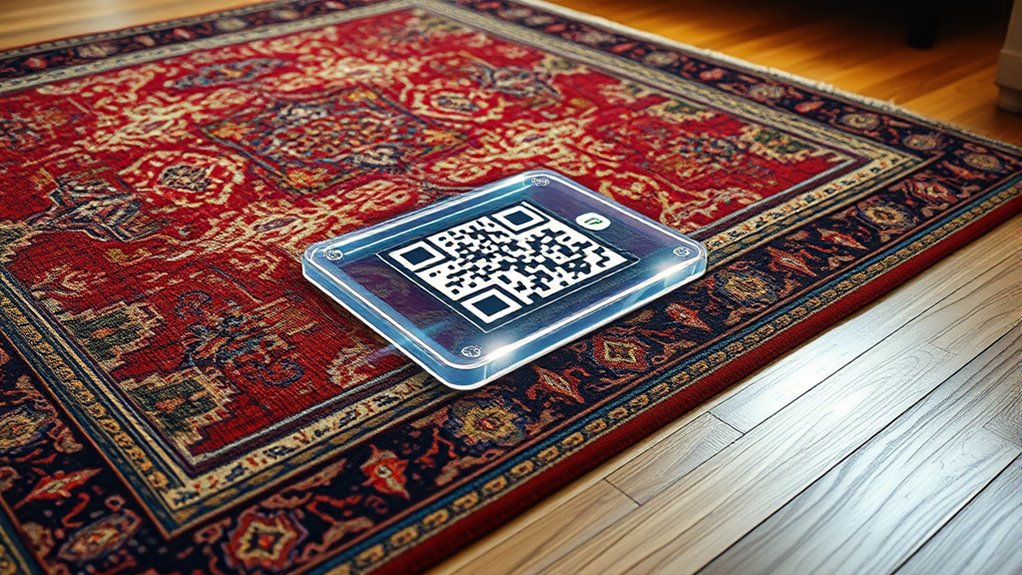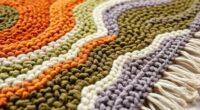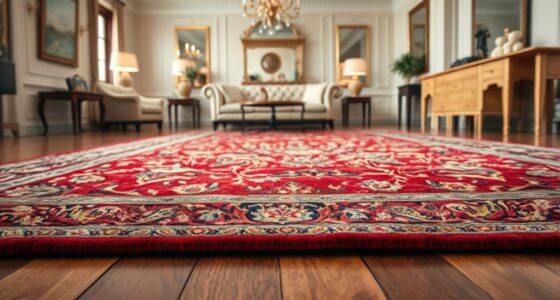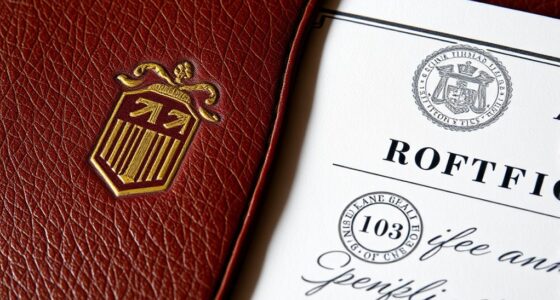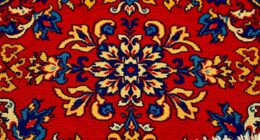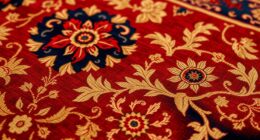NFTs and digital provenance use blockchain technology to securely verify the authenticity, origin, and ownership history of physical rugs. By linking rugs to digital certificates or creating digital twins, you can easily prove provenance, prevent counterfeiting, and simplify ownership transfers. While challenges like environmental impact and physical security exist, many successful applications are emerging in the market. Keep exploring to discover how these innovations can revolutionize rug collection and trading.
Key Takeaways
- NFTs serve as digital certificates that verify the authenticity and provenance of physical rugs on the blockchain.
- Digital provenance ensures transparent, tamper-proof records of a rug’s history, origin, and ownership.
- Creating a digital twin links the physical rug to its NFT, enhancing security and trust in its value.
- Blockchain technology prevents counterfeiting and simplifies ownership transfers of rugs globally.
- Integrating NFTs with physical rugs preserves cultural significance and provides reliable, traceable provenance records.
Understanding Digital Provenance and Its Significance
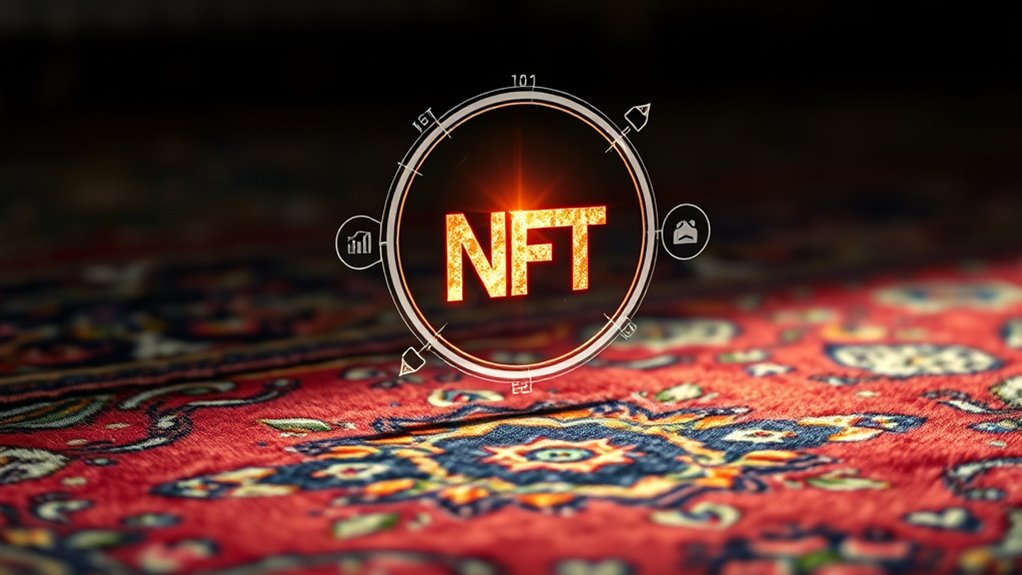
Digital provenance refers to the verified history and origin of a digital asset, ensuring its authenticity and ownership are transparent. Understanding this helps you appreciate the historical context behind a piece, revealing its journey through time and ownership. For rugs, digital provenance can preserve their cultural significance, linking them to specific regions, artisans, or traditions. This record assures collectors and buyers that the rug’s story is genuine, not fabricated. It also helps protect against counterfeit or stolen items by providing a clear, tamper-proof history. As digital provenance deepens your connection to a piece’s background, it highlights its value beyond aesthetics—emphasizing its cultural importance and historical roots. This transparency fosters trust and appreciation, making your investment more meaningful.
The Role of Blockchain in Authenticity Verification
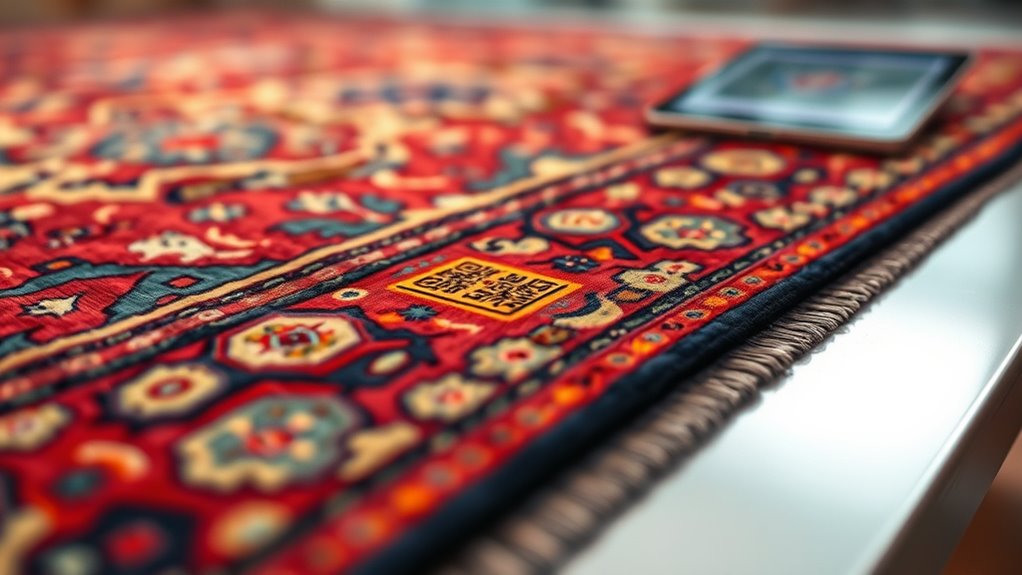
Blockchain technology plays a pivotal role in guaranteeing the integrity of provenance records for rugs by providing a secure, transparent ledger of ownership and history. This ledger records every transaction, making it nearly impossible to alter or counterfeit the rug’s history. As cryptocurrency mining validates new blocks, it maintains the blockchain’s security and decentralization, preventing fraud. Additionally, blockchain scalability remains a challenge; as more rugs are verified, the network must handle increased data without compromising speed or security. This ensures that each rug’s authenticity can be verified quickly and reliably. By leveraging blockchain’s decentralized nature, you gain confidence that the provenance information is tamper-proof, fostering trust between buyers, sellers, and collectors in the rug market. Furthermore, implementing security protocols helps protect the blockchain network from potential vulnerabilities and attacks. Understanding the importance of network consensus mechanisms also enhances the robustness of the blockchain, ensuring consistent validation across the network. Incorporating decentralized validation processes further strengthens the system’s resilience and trustworthiness. Additionally, the use of cryptographic techniques guarantees the privacy and integrity of sensitive provenance data within the network.
How NFTs Can Represent Physical Rug Ownership

NFTs can serve as digital certificates of authenticity, proving a rug’s provenance and ownership. They enable secure transfer of ownership without physical handoffs, reducing the risk of fraud. By linking NFTs to physical rugs, you create a trustworthy record that’s easy to verify and transfer. Incorporating paint sprayer technology principles can also help in understanding how secure and efficient digital provenance systems might be designed. Additionally, integrating AI-powered verification methods can further enhance the trustworthiness of these digital records. Understanding digital security measures is crucial for safeguarding ownership records and preventing tampering. Employing robust encryption techniques can ensure that ownership data remains confidential and tamper-proof. Exploring blockchain validation processes can provide additional layers of security and transparency for the provenance data.
Digital Certificates of Authenticity
When you own a valuable rug, verifying its authenticity can be a challenge, especially when trying to prove ownership or provenance. Digital certificates of authenticity, powered by NFTs, offer a clear solution. These certificates act like digital art credentials, uniquely linking the physical rug to a blockchain record. You can display or verify this certificate easily in virtual galleries or online platforms, ensuring transparency. This digital proof isn’t easily tampered with, providing confidence to buyers and collectors. By attaching a digital certificate of authenticity to your rug, you create an immutable record that confirms its origin, age, and provenance. This method simplifies verification, reduces fraud, and enhances trust in the value of your rug. It’s a modern way to safeguard and showcase your prized possession. Divorce process in various states highlights the importance of clear legal documentation and procedures, similar to how digital certificates provide clear proof of ownership.
Secure Ownership Transfer
Securely transferring ownership of a valuable rug can be complicated, especially across distances or through traditional methods. Using NFTs, you can represent the rug’s ownership digitally, making the process seamless and tamper-proof. When you sell or buy a rug, transferring the NFT instantly updates ownership in the digital art and art market spaces, ensuring authenticity and reducing fraud. This method simplifies international transactions and provides clear proof of provenance. Both collectors and dealers benefit from the secure, transparent transfer process, which is especially valuable for high-value or rare rugs. By integrating NFTs, you can confidently move physical rug ownership without the delays or risks associated with traditional paperwork, creating a more efficient and trustworthy system for the art market. Understanding how blockchain technology underpins NFT transactions helps ensure secure and reliable ownership transfers. Additionally, leveraging tuning techniques from vehicle customization demonstrates how precise digital processes can enhance confidence and performance in various fields. Furthermore, implementing secure payment solutions can streamline transactions and provide additional protection against fraud in the ownership transfer process. Incorporating security measures such as encryption and digital signatures is crucial for maintaining the integrity of ownership records. Embracing these digital innovations fosters a mindset of calm and confidence, reducing anxiety associated with complex transactions and helping you approach ownership transfers with clarity and peace of mind.
Creating a Digital Twin: Linking Physical Rugs to NFTs

Creating a digital twin involves linking a physical rug to its corresponding NFT, establishing a verifiable connection between the tangible item and its digital representation. This process helps preserve the rug’s cultural significance and highlights its unique craftsmanship. By associating an NFT with the physical piece, you create a secure, traceable record that enhances its authenticity and provenance. This digital link enables potential buyers and collectors to access detailed information about the rug’s history, origin, and significance, boosting its aesthetic appeal. Furthermore, creating a digital twin ensures that the rug’s value is preserved and easily verified in the digital space, fostering trust and confidence in its authenticity. It’s an innovative way to marry tradition with technology, elevating the perception of cultural treasures like rugs. Additionally, this approach aligns with the principles of provenance as emphasized in the Law of Attraction resource guide. Incorporating blockchain technology ensures that the record remains tamper-proof and transparent, further reinforcing trust in the digital provenance.
Benefits of Implementing Digital Provenance for Collectors and Dealers
Implementing digital provenance helps you verify the authenticity of rugs quickly and confidently, reducing the risk of forgeries. It also makes tracking ownership changes seamless, giving you a clear history of each piece. These benefits can boost trust and efficiency for both collectors and dealers.
Enhanced Authenticity Verification
Digital provenance considerably enhances the ability of collectors and dealers to verify the authenticity of rugs. Relying on traditional authentication and physical inspection can sometimes be subjective or limited. Digital records provide a secure, tamper-proof way to confirm a rug’s true origin. With digital provenance, you can:
- Instantly verify authenticity through blockchain-verified history.
- Reduce reliance on subjective assessments or physical inspection alone.
- Detect counterfeit or altered rugs more effectively, safeguarding your investments.
Streamlined Ownership Tracking
By adopting digital provenance, collectors and dealers can effortlessly track the full ownership history of a rug, ensuring transparency at every stage. This streamlines the process in the art market, eliminating the need for cumbersome traditional documentation that can be lost or forged. With digital records, you gain instant access to verified ownership data, making transactions faster and more secure. It reduces the risk of disputes and enhances trust between buyers and sellers. Digital provenance also simplifies provenance verification for dealers, helping them authenticate and price rugs more accurately. By moving beyond paper trails, you create a clear, tamper-proof record that benefits everyone involved. Overall, this technology transforms ownership tracking into a seamless, reliable system that strengthens confidence in the market.
Challenges and Limitations of Using NFTs for Physical Artifacts
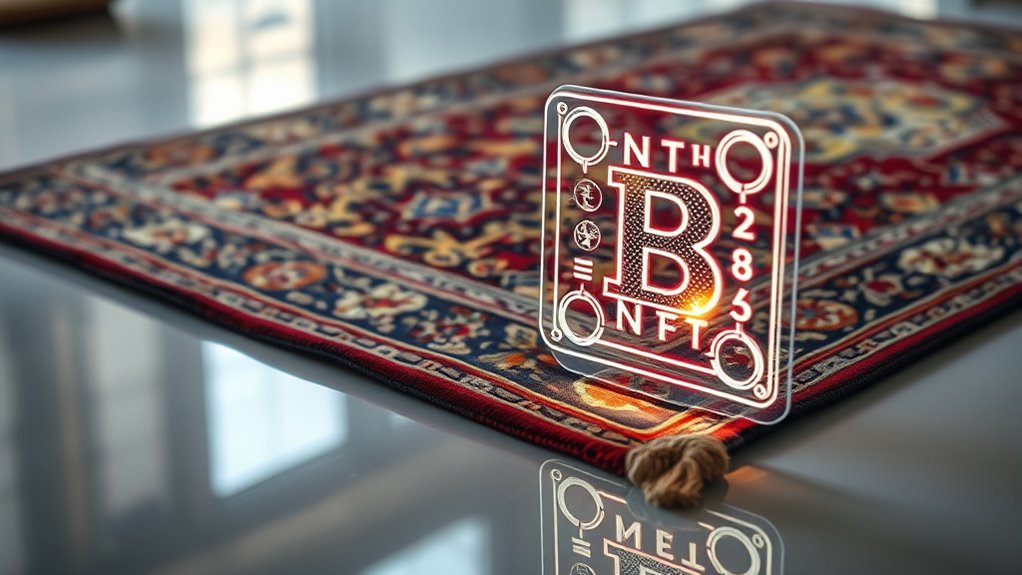
Using NFTs to authenticate physical artifacts introduces several challenges that can undermine their effectiveness. First, the reliance on digital art and blockchain technology doesn’t prevent physical theft or damage. Second, the environmental impact of minting NFTs can be significant, raising sustainability concerns. Third, the connection between the digital token and the actual physical rug can be fragile; if the link is compromised, so is the provenance. Additionally, the value of NFTs in virtual real estate or digital art markets doesn’t always translate to tangible assets. This disconnect can make potential buyers hesitant. Overall, while NFTs offer innovative solutions, issues like security, environmental impact, and the digital-physical gap limit their current utility for physical artifacts like rugs.
Case Studies: Successful Integration of NFTs in the Rug Market
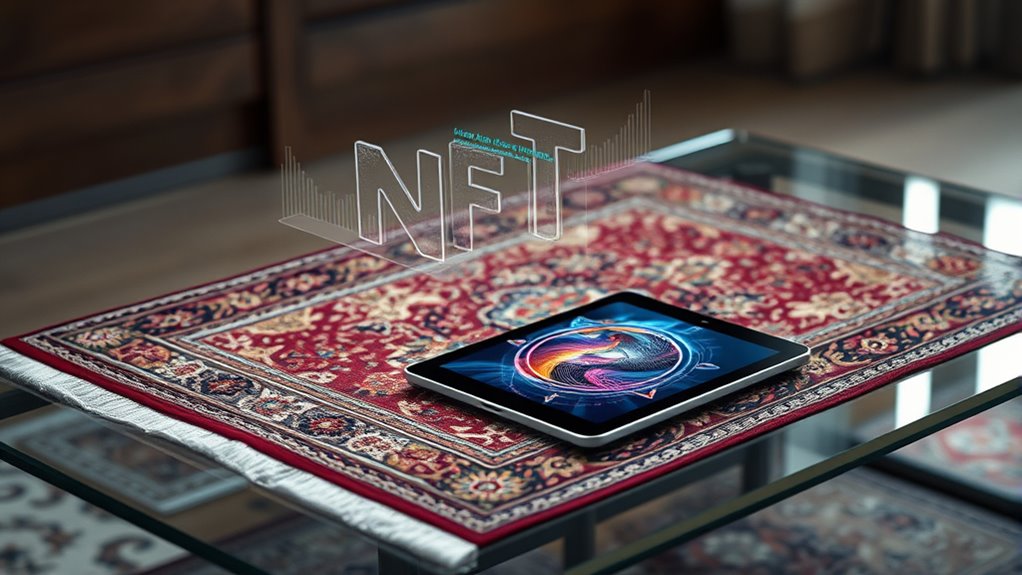
Several rug collectors and dealers have successfully integrated NFTs to authenticate and showcase their prized pieces, demonstrating the technology’s potential in the traditional market. These case studies highlight how NFTs preserve the cultural significance of unique rugs while emphasizing their artistic expression. By linking digital tokens to physical rugs, owners can verify provenance, prevent forgery, and celebrate craftsmanship. For example, a renowned dealer used NFTs to document a rare Anatolian rug, ensuring its history and cultural value remain intact. Artists and artisans also benefit by showcasing their work through digital ownership, reaching a global audience. These integrations prove that NFTs can enhance appreciation for traditional artistry, blending modern technology with cultural heritage to elevate the rug market’s authenticity and significance.
Future Trends and Innovations in Rug Provenance Tracking

The integration of NFTs into the rug market has already showcased how digital tokens can secure provenance and celebrate craftsmanship. Looking ahead, future trends will deepen the cultural significance and artistic expression tied to these pieces. You can expect innovations such as:
- Enhanced storytelling through immersive digital experiences linked to NFTs, highlighting the cultural backgrounds of each rug.
- Interactive platforms allowing collectors to explore the artistic journey behind every creation, fostering appreciation of craftsmanship.
- Cross-cultural collaborations that blend traditional motifs with modern digital art, elevating artistic expression and expanding global reach.
These advancements will make rug provenance more meaningful, connecting owners and audiences to the cultural roots and artistic stories embedded in each rug’s history.
Practical Steps to Digitize and Secure Rug Ownership Records
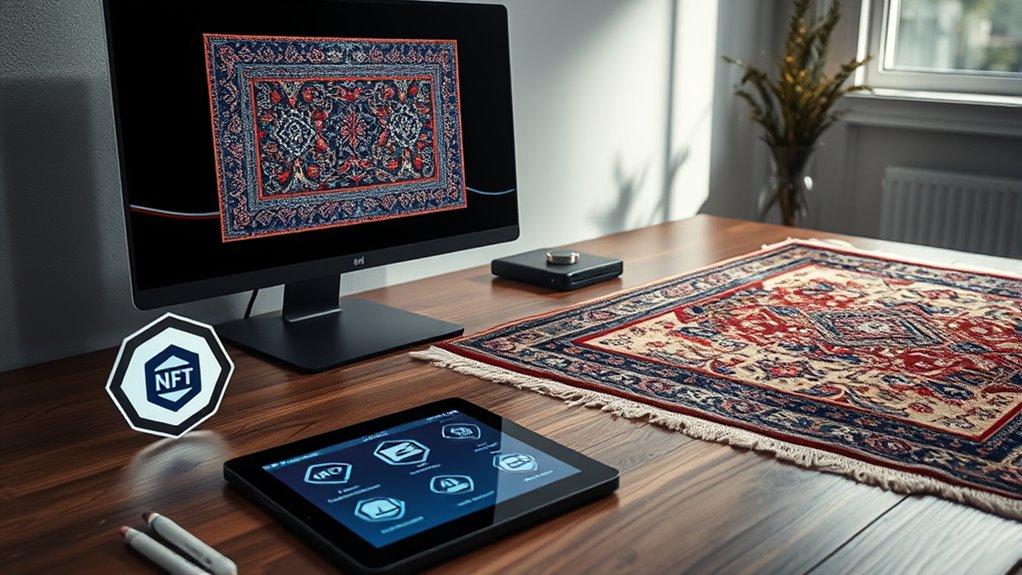
To effectively digitize and secure rug ownership records, you need to establish a clear process that combines reliable digital tools with robust security measures. Start by documenting the rug’s traditional craftsmanship details, including origin, materials, and craftsmanship techniques. Use blockchain technology or NFT platforms to create a digital proof of ownership, ensuring the record remains tamper-proof. Regularly update digital records with rug maintenance history, preserving its value and authenticity over time. Implement secure authentication methods, like multi-factor authentication or digital signatures, to prevent unauthorized access. Educate yourself on best practices for digital security and data management. This systematic approach not only safeguards your ownership records but also enhances the rug’s provenance, making it easier to verify authenticity and maintain its value for years to come.
Frequently Asked Questions
How Does Digital Provenance Affect Rug Valuation and Pricing?
Digital provenance impacts rug valuation by establishing digital authenticity, which assures buyers of a rug’s genuine origin. This transparency increases buyer confidence, often leading to higher prices. You’ll find that market transparency, fueled by digital records, reduces uncertainties and makes transactions smoother. When you verify a rug’s digital provenance, you’re more likely to pay a fair value, knowing its history is accurately documented and authentic.
What Are the Legal Implications of Nft-Based Ownership?
You need to understand that NFT-based ownership has legal implications, especially concerning intellectual property rights and regulatory compliance. When you create or buy an NFT, you’re fundamentally acquiring a digital certificate of ownership, but it doesn’t automatically transfer copyright or other rights unless explicitly stated. You must guarantee compliance with existing laws to avoid disputes, and be aware that intellectual property laws vary by jurisdiction, affecting your rights and responsibilities.
Can NFTS Prevent Counterfeit Rugs in the Market?
Sure, NFTs promise to prevent counterfeit rugs, but don’t be fooled—digital watermarking and authenticity verification aren’t foolproof. You might think that an NFT can guarantee real ownership, yet counterfeiters often find ways around digital proofs. While these tools help authenticate, they can’t fully stop fakes from flooding the market. So, yes, NFTs can assist, but they’re no magic shield against the ever-persistent counterfeit problem.
How Secure Are NFTS Against Hacking or Fraud?
You wonder how secure NFTs are against hacking or fraud. While they use blockchain technology, which offers strong security, there are still cybersecurity challenges and blockchain vulnerabilities that exist. You need to be aware that hackers can exploit certain weaknesses, so it’s essential to use secure wallets and stay updated on security practices. Overall, NFTs provide a good level of security, but they’re not entirely immune to cyber threats.
What Costs Are Associated With Implementing NFT Provenance Systems?
Imagine integrating blockchain for rug provenance; you’ll face costs like developing or purchasing a platform, which can range from thousands to tens of thousands of dollars. You’ll also need to guarantee smart contract security to prevent vulnerabilities. These expenses cover blockchain integration, smart contract audits, and ongoing maintenance. While initial costs may seem high, they’re essential for creating a transparent, tamper-proof record that boosts buyer confidence and protects your brand.
Conclusion
Think of NFTs and blockchain as a sturdy lighthouse guiding you through the fog of authenticity. By embracing digital provenance, you’ll illuminate the true value of your rugs, making each one a beacon of trust in a sea of uncertainty. With these tools, you can navigate ownership securely and confidently, ensuring your prized pieces shine brightly for generations to come. Embrace this digital revolution and let your rugs tell their authentic story.
